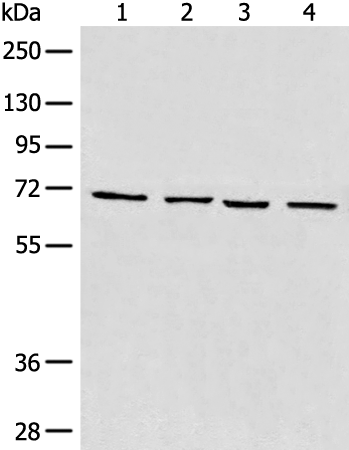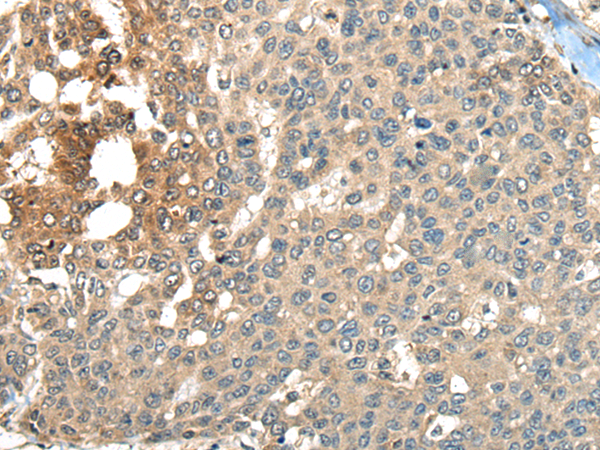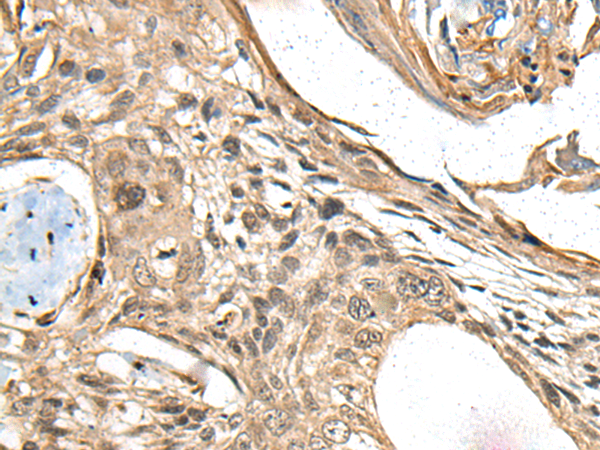


| WB | 1/1000 | Human,Mouse,Rat |
| IF | 咨询技术 | Human,Mouse,Rat |
| IHC | 1/100-1/500 | Human,Mouse,Rat |
| ICC | 技术咨询 | Human,Mouse,Rat |
| FCM | 咨询技术 | Human,Mouse,Rat |
| Elisa | 咨询技术 | Human,Mouse,Rat |
| Aliases | ERK4; ERK-4; PRKM4; p63MAPK; p63-MAPK |
| WB Predicted band size | 66 kDa |
| Host/Isotype | Rabbit IgG |
| Antibody Type | Primary antibody |
| Storage | Store at 4°C short term. Aliquot and store at -20°C long term. Avoid freeze/thaw cycles. |
| Species Reactivity | Human, Mouse |
| Immunogen | Synthetic peptide of human MAPK4 |
| Formulation | Purified antibody in PBS with 0.05% sodium azide and 50% glycerol. |
+ +
以下是关于SCYL1 (N-term)抗体的3篇参考文献及其摘要概括:
---
1. **文献名称**:*SCYL1 regulates COPII-mediated vesicular trafficking in neuronal cells*
**作者**:Burgo A, et al.
**摘要**:利用SCYL1 (N-term)抗体进行免疫印迹和免疫荧光实验,研究发现SCYL1通过与COPII囊泡组分相互作用,调控神经元内质网-高尔基体的运输过程,其缺失导致囊泡堆积和神经元功能障碍。
2. **文献名称**:*SCYL1 controls the maintenance of neuronal Golgi architecture through ARF1-mediated regulation*
**作者**:Ishizuka Y, et al.
**摘要**:通过SCYL1 N端特异性抗体进行蛋白质定位分析,揭示SCYL1通过激活ARF1调控高尔基体结构稳定性的分子机制,并证明其突变与神经退行性疾病相关。
3. **文献名称**:*SCYL1 is a key regulator of the JNK signaling pathway in response to cellular stress*
**作者**:Matsuoka K, et al.
**摘要**:研究采用SCYL1 (N-term)抗体进行免疫沉淀和功能缺失实验,发现SCYL1通过结合JNK激酶调控细胞应激反应通路,其N端结构域对信号传导至关重要。
---
以上文献均通过SCYL1的N端抗体探究其在不同细胞过程中的功能,涵盖囊泡运输、细胞器结构调控及信号通路等领域。
The SCYL1 (N-term) antibody is a polyclonal or monoclonal antibody specifically designed to target the N-terminal region of the SCYL1 protein (SCY1-like protein 1), a member of the SCY1-like family of kinases. SCYL1 is implicated in intracellular trafficking and signaling, with roles in regulating COPI-mediated vesicle transport between the Golgi apparatus and endoplasmic reticulum (ER). Structurally, SCYL1 contains an N-terminal kinase-like domain (lacking catalytic activity) and C-terminal motifs that mediate protein-protein interactions. The N-terminal region is critical for its interaction with components of the coatomer complex and its involvement in maintaining Golgi-ER dynamics.
This antibody is commonly used in research applications such as Western blotting (WB), immunoprecipitation (IP), and immunofluorescence (IF) to detect endogenous SCYL1 expression levels, subcellular localization, and interactions. It helps elucidate SCYL1's functional roles, including its links to neurodegenerative disorders (e.g., mutations in SCYL1 are associated with motor neuron dysfunction in mice) and cellular stress responses. Studies using this antibody have also explored SCYL1's involvement in DNA damage repair and cell cycle regulation. Validation typically includes testing reactivity in human, mouse, and rat samples, with specificity confirmed by knockout controls or siRNA knockdown. Researchers rely on this tool to investigate SCYL1's molecular mechanisms in health and disease.
×